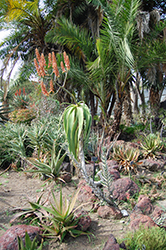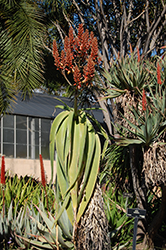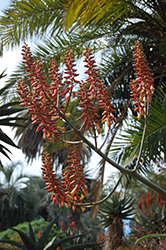It's all about ...
plants

Plant Height: 8 feet
Flower Height: 12 feet
Spread: 3 feet
Sunlight:
![]()
Hardiness Zone: 9b
Other Names: syn. Aloe gillilandii
Description:
A tree variety with a curving, unbranched trunk, topped with an impressive, side facing rosette of long, pale green leaves that drape downward; produces upright, conical racemes of tubular orange flowers in mid-winter; a great garden or landscape accent
Ornamental Features
Yemen Tree Aloe features showy racemes of orange tubular flowers rising above the foliage from mid to late winter. It has attractive grayish green foliage with hints of chartreuse. The large succulent sword-like leaves are highly ornamental and remain grayish green throughout the winter. The mottled gray bark adds an interesting dimension to the landscape.
Landscape Attributes
Yemen Tree Aloe is an evergreen tree with a shapely form and gracefully arching branches. Its strikingly bold and coarse texture can be very effective in a balanced landscape composition.
This is a relatively low maintenance tree, and usually looks its best without pruning, although it will tolerate pruning. Deer don't particularly care for this plant and will usually leave it alone in favor of tastier treats. Gardeners should be aware of the following characteristic(s) that may warrant special consideration;
- Spiny
Yemen Tree Aloe is recommended for the following landscape applications;
- Accent
- Rock/Alpine Gardens
- General Garden Use
- Container Planting
Planting & Growing
Yemen Tree Aloe will grow to be about 8 feet tall at maturity extending to 12 feet tall with the flowers, with a spread of 3 feet. It has a low canopy with a typical clearance of 4 feet from the ground, and is suitable for planting under power lines. It grows at a medium rate, and under ideal conditions can be expected to live for 40 years or more.
This tree should only be grown in full sunlight. It prefers dry to average moisture levels with very well-drained soil, and will often die in standing water. It is considered to be drought-tolerant, and thus makes an ideal choice for xeriscaping or the moisture-conserving landscape. It is not particular as to soil pH, but grows best in sandy soils. It is somewhat tolerant of urban pollution. This species is not originally from North America. It can be propagated by cuttings.
Yemen Tree Aloe is a fine choice for the yard, but it is also a good selection for planting in outdoor pots and containers. Because of its height, it is often used as a 'thriller' in the 'spiller-thriller-filler' container combination; plant it near the center of the pot, surrounded by smaller plants and those that spill over the edges. It is even sizeable enough that it can be grown alone in a suitable container. Note that when grown in a container, it may not perform exactly as indicated on the tag - this is to be expected. Also note that when growing plants in outdoor containers and baskets, they may require more frequent waterings than they would in the yard or garden. Be aware that in our climate, most plants cannot be expected to survive the winter if left in containers outdoors, and this plant is no exception. Contact our experts for more information on how to protect it over the winter months.
This plant is not reliably hardy in our region, and certain restrictions may apply; contact the store for more information.


